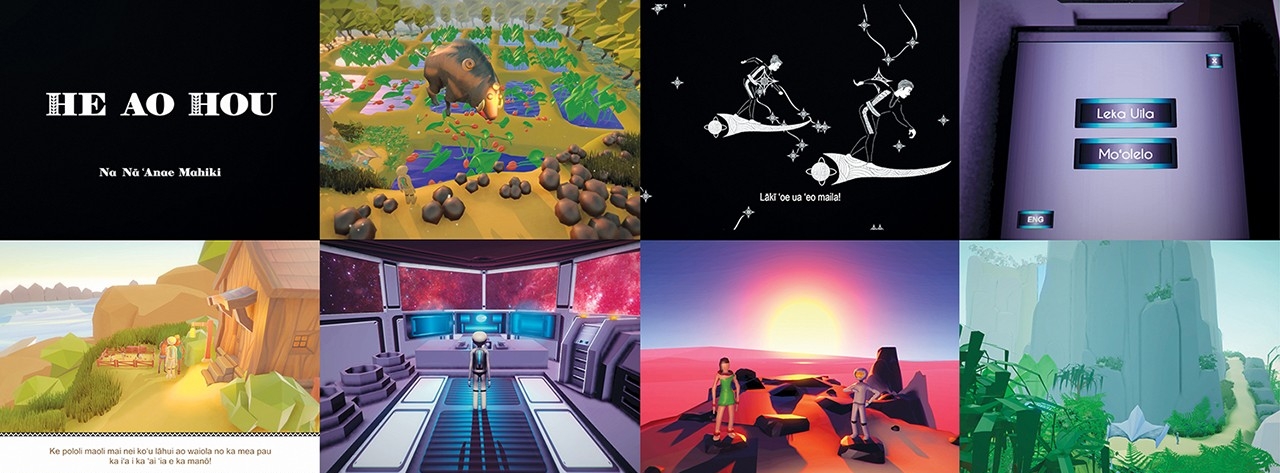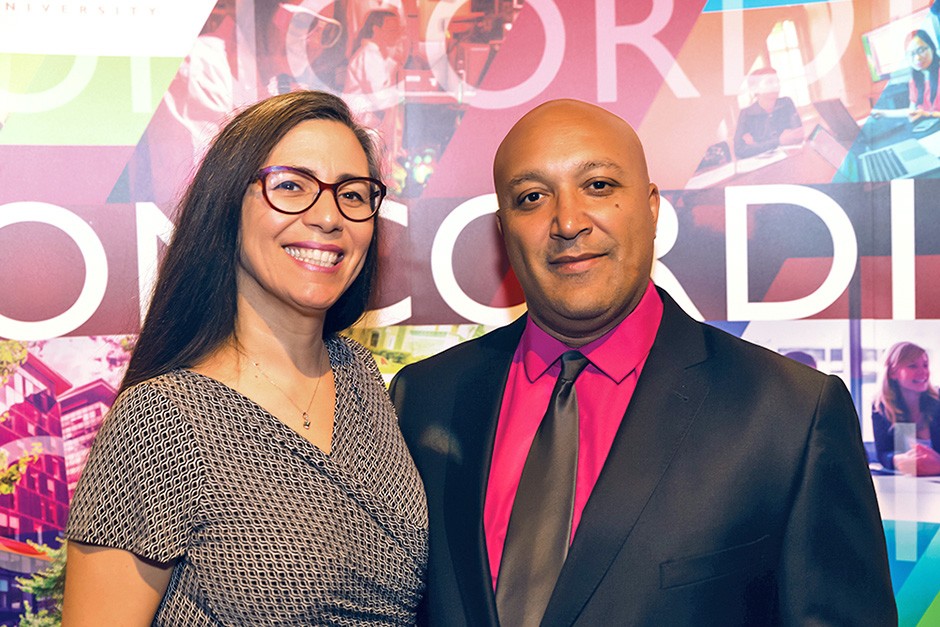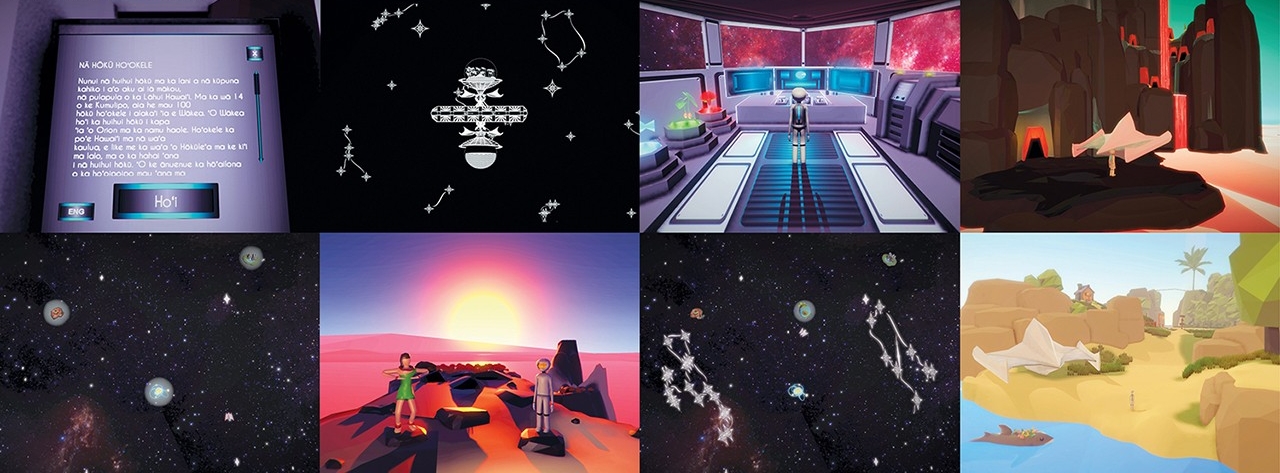The activity’s storytelling element also ensures that what is designed usually stands out from typical video game fare. “We have elders come in and tell stories, and then we talk about why stories are important and how they are structured,” says Lewis. “The participants devise a story that they are going to use the video game to tell. They almost always take ingredients from different stories they’ve been telling and talking about and remixing them into an interactive form.”
The IIF residence program offers Indigenous artists, writers, activists and think- ers an opportunity to explore Indigenous futures at AbTeC headquarters in Concordia’s Engineering, Computer Science and Visual Arts Integrated Complex. Lewis jokes that the project offers residents so much leeway that they often do not believe what they are being asked. “They write a one-page proposal that includes a budget and if our committee feels confident that it’s a worthwhile venture, then they come and hopefully do some interesting work,” he says.
Scott Benesiinaabandan is the project’s long-term artist-in-residence. He pro- duced a virtual reality (VR) work, Blueberry Pie Under the Martian Sky, that was shown at Concordia’s Leonard and Bina Ellen Art Gallery in fall 2017. The exhibition, Owerà:ke Non Aié:nahne / Combler les espaces vides / Filling in the Blank Spaces, was a joint creative project by Lewis and Skawennati.
“The whole premise of the piece was looking at our communities 150 years into the future,” says Benesiinaabandan. The narrative nature of language is what served as his inspiration. “Language encapsulates all things. It is the most important piece of culture and determines how culture gets propagated into the future. Language is a foundational element,” he says.
The VR commission also marked the first time Benesiinaabandan worked with the medium. While he admits that the work is a per- sonal exploration of how he considers language, he hopes viewers take away a “visceral sense of being in a different world,” he says. “I use a lot of digital media, so this artwork was just another exploration into that. It was a great learning opportunity too, because now I have a background in VR.”
While Lewis is happy with the work the IIF and its partners are doing, he wants to expand the conversation to include members of the public. That is the idea behind the Symposium on the Future Imaginary, which wrapped up its third edition at the Winnipeg Art Gallery in December 2017.
“We’ve made a significant difference in growing that conversation through the symposium because each one is videotaped and posted online,” he says. “One of the big commitments we made at the beginning of the grant that gets carried out through the cluster is to record as much as we can and get it online so people can see it.”
Lewis is pleased the symposium has grown since it was first held in Toronto in 2015. Still, it is also clear that its success does not lie solely on the shoulders of the IIF team. “It’s not just because of what we’re doing,” he says. “There are other people who are doing work in what they call Indigenous Futurisms that are really helping break open the conversation.”
Research inspired by sci-fi, art, elders
Both Lewis and Skawennati grew up with a love for science fiction. But after years and years of reading science fiction novels, they began to notice how few Indigenous people actually populate the genre.
This realization is what propelled Skawennati to ex- amine what lies ahead for First Nations people more closely. “I really felt I needed to do something useful and I couldn’t just make art that was pretty,” recalls Skawennati. “A lot of the Native art in the late ’90s was about being a victim and I wasn’t interested in being a victim.”
The first artwork in which she decidedly envisioned Indigenous people in the future was an online paper-doll/time-travel journal called Imagining Indians in the 25th Century. The project’s timeline takes place over a millennium and sees the main character visit 10 events over the course of that time. Skawennati cre- ated a different costume for the character to wear at each event, along with 10 separate journal entries.
The project is not only set in the future, though.
“I don’t want to pretend I’m a historian, but I’m an artist who does a good amount of historical research. Imagining Indians starts in 1490 — two years before the arrival of Christopher Columbus — and ends in 2490. It’s one millennium but only half of it is in the future,” Skawennati explains.



 Jason Edward Lewis (right), is professor in Concordia’s Department of Design and Computation Arts, Concordia University research chair in computational media and the Indigenous Future Imaginary, and co-director of the Indigenous Futures research cluster.
Skawennati (left), is the partnership coordinator for Concordia’s initiative for Indigenous Futures, housed in the indigenous futures research cluster. In 2017 the artist completed three major projects, including a public art project and two machinimas — movies made in virtual worlds — She falls for ages and The peacemaker returns.
Jason Edward Lewis (right), is professor in Concordia’s Department of Design and Computation Arts, Concordia University research chair in computational media and the Indigenous Future Imaginary, and co-director of the Indigenous Futures research cluster.
Skawennati (left), is the partnership coordinator for Concordia’s initiative for Indigenous Futures, housed in the indigenous futures research cluster. In 2017 the artist completed three major projects, including a public art project and two machinimas — movies made in virtual worlds — She falls for ages and The peacemaker returns.

 Heather Igloliorte is an assistant professor in the Department of Art History and co-director of the Indigenous Futures research cluster.
Heather Igloliorte is an assistant professor in the Department of Art History and co-director of the Indigenous Futures research cluster.